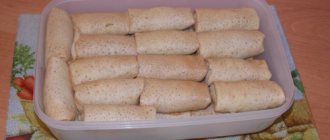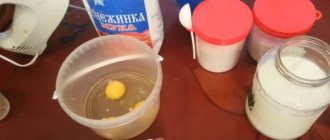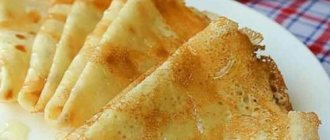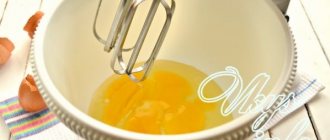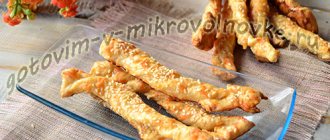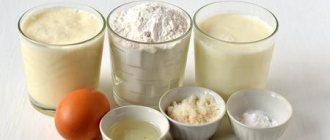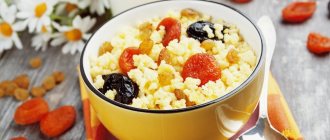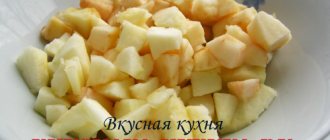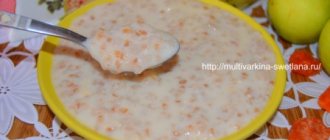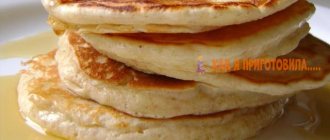Thin pancakes with holes
Holes in pancakes made with milk powder are made by using slaked soda. Main components:
- wheat flour –80–200 g;
- powdered milk – 2 tbsp. l. with a slide;
- granulated sugar – 2 tsp. with a slide;
- salt, citric acid;
- 200 ml water;
- one egg;
- quarter tsp soda;
- sunflower oil – 1 tsp;
Cooking time – 1 hour; calorie content –360 kcal/100 g.
Pour the powdered milk mixture into warm boiled water and mix. Next add salt, sugar and egg. After thoroughly whisking, there should be no lumps left. Soda is quenched with citric acid in a large spoon.
After adding a few drops of water, the quenching process begins. After adding it to the dough and mixing, you can begin to gradually add flour. To obtain a uniform consistency, use a whisk.
The dough needs to be made liquid, then the pancake will turn out thin. You can leave it to stand for 20 minutes until the lumps are completely dissolved.
Oil is poured into a frying pan and heated for 20 minutes until hot. You need to create a funnel in the center of the dough, stirring it constantly. Hot oil is poured into this funnel. You can pour a portion of the dough into the pan and bake the first pancake.
Using pancake flour
On the shelves of modern supermarkets there are various products that greatly simplify the life of housewives. One of these products is special pancake flour. It is a mixture of ready-made ingredients. Manufacturers make it based on regular wheat flour, granulated sugar, egg powder, milk powder, salt, baking powder and citric acid.
Making baked goods from a special mixture is very simple. Manufacturers provide a recipe on the packaging. For preparation, as a rule, it is suggested to add 500 g of the mixture to 800 ml of water. After thoroughly stirring until smooth, just one ingredient is added to the dough - 3 or 4 tbsp. spoons of sunflower oil - and start baking.
Pancakes made with milk powder or from a special mixture are a quick and economical option. At the same time, the finished dish is in no way inferior in taste to ordinary pancakes made from plain flour and milk.
Mama66.ru
Pancake recipe Prostushka
Pancakes according to this recipe are tender with a persistent milky aroma. And they are absolutely easy to prepare and require minimal time to prepare the dough. And the result is worth it - ruddy and golden, thin, delicious sunshine.
What is needed for this:
- large chicken egg;
- five tablespoons of milk powder with a small slide;
- a little sugar and salt;
- half a teaspoon of salt or a pack of ripper;
- half a large cup of wheat flour;
- a large cup of water;
- a quarter cup of vegetable oil.
How to do:
- First you need to dilute the milk with water and get a liquid milk component. To do this, pour a little water into the milk powder and stir until smooth. And add the remaining water in parts.
- In another container, stir the egg, salt and granulated sugar until the grains dissolve and the mixture turns white.
- Add vegetable oil.
- Add baking powder or baking soda to the flour. Mix.
- Add flour to egg mixture. Mix.
- Gradually introduce milk liquid. Stir until smooth.
- Cover with a towel and let sit for at least a quarter of an hour.
- Stir and bake pancakes in a heated frying pan, greased with a piece of fresh lard.
Let's help our smaller brothers
Powdered milk is used not only for industrial and food purposes. It is actively used by breeders for feeding piglets, lambs, kids, and calves. How to breed milk powder for piglets? The proportions are clearly indicated on the packaging. As practice shows, the proportion of dry matter is 15-20% per 1 liter of liquid.
The rules for diluting these mixtures are the same as for food purposes. But many farmers say that using milk powder in its pure form to feed piglets is not economically profitable. It is better to purchase special mixtures and also add vitamins. Approximately 1 liter of this mixture will replace 0.5 liters of sow milk for a piglet.
If you don’t have regular milk on hand, what can you replace it with? Powdered milk of course! This is an excellent alternative that has several advantages.
- Firstly, in terms of the amount of useful substances it is almost as good as liquid.
- Secondly, it lasts much longer.
It can also be used in the preparation of milk porridges, baked goods, casseroles, omelettes and other dishes. Sometimes manufacturers specifically add powdered milk to baked goods because this makes them more fluffy.
Pancakes with milk powder
Delicious homemade pancakes are the pride of every housewife, because it is not always possible to bake exactly the pancakes you want. Usually milk is used to knead the dough, but what to do when you don’t have it on hand? It's very simple - replace whole milk with dry milk. Believe me, pancakes made with milk powder turn out excellent!
It is worth noting that there is no need to pre-dilute the dry product with water.
It is important to mix the dry ingredients first, and then start adding liquid and kneading. Try to achieve a uniform consistency of the dough without small lumps, then the pancakes will turn out thin and incredibly tender
Remember, pancakes must be baked in refined vegetable oil. Thanks to this, the dough will not have any foreign odors or tastes. Follow the recommendations below and you will definitely succeed.
If desired, store-bought milk powder can be replaced with baby food powder.
Composition of the product
It is easy to verify the value of a dry product if you study the composition. The powder has a calorie content of up to 550 kcal per 100 g of weight. The low-fat version has a low calorie content - up to 370 kcal.
The product contains about 26 g of protein, which attracts bodybuilders, fat - 27 g, carbohydrates - 38 g. This contrast in the composition with liquid milk is explained simply: after dilution with water, the amount of BJU and other elements will decrease, if you count from 100 ml of the finished product product.
This milk is rich in vitamins: A, group B, D, C, PP, E. It contains a lot of potassium, sodium, iron, iodine, calcium, manganese, sulfur, selenium, potassium, magnesium, essential amino acids.
The composition of the powder will differ depending on the type:
- Whole.
The powder is distinguished by its content of the highest percentage of fat content. However, for this reason it is considered the most nutritious. Due to the high fat content, the shelf life of whole milk powder is short compared to other types. This type of powder is usually used by housewives in cooking. - Low fat.
From the name it is clear that there is a minimum fat content. The technology is such that whole milk is used to obtain the powder, but after first removing excess fat from it. This skim milk is then dried in equipment. The result is a low-fat powder that can be stored for up to 9 months. It is usually used to add to confectionery products. But it is also often used at home, as it is less harmful to health. There is also demand for powder from cheese factories. - Instant powder.
It is used, as a rule, in the production of baby food and those products for which the fastest possible dissolution is important. The powder is rich in all the compounds described above. The technology simply changes: after the first drying, the resulting components are mixed, moistened and re-dried.
Cooking steps
Sift the flour into a bowl along with baking powder, then sift the milk powder, mix, add salt and sugar, mix again.
Heat water to a temperature no higher than 50 degrees and add 150-200 ml to the dough. Stir the dough thoroughly so that no lumps form.
Break the egg into the dough and mix thoroughly.
Carefully pour the remaining water into the dough. The amount of water can be adjusted at your discretion - if you add more, the pancakes will be thinner.
Heat the frying pan well and grease it with vegetable oil using a silicone brush. Pour pancake batter into a ladle and, tilting the pan, spread the batter evenly over the surface.
Brown the bottom of the pancake over medium heat, then flip and fry the other side. Bake all the pancakes in this way, brushing the frying pan every 1-2 pancakes until the dough is gone.
Place pancakes on a plate.
Place the pancakes in four on a plate and serve. As an addition to them, you can serve jam, honey or condensed milk. This is how easy it is to prepare delicious, thin, tasty pancakes mixed with milk powder.
rutxt.ru
Pancakes with milk powder and yeast
Pancakes, familiar from childhood, are made using yeast according to my grandmother’s recipe. Yeast dough consists of:
- 1.5 cups sifted flour;
- 500 ml water;
- 5 tbsp. l. milk powder;
- three eggs;
- 15 g dry yeast;
- 0.5 cups sugar;
- thirds tsp salt;
- 4 tbsp. l. sunflower oil.
Baking time: just over 1 hour; calorie content – 200 kcal/100 g.
Sugar, yeast, and salt dissolve in a glass of powdered milk diluted with warm water. After the yeast has dispersed, you can add half a glass of flour. The dough is covered with a towel until the fermentation process begins.
The dough with the dough will make the pancakes fluffier. If you're short on time, you can simply add all the ingredients and let the dough rise. All that remains is to pour in the remaining milk, flour and beat in the eggs.
After adding oil, the dough is allowed to brew again in a warm place. As soon as the dough begins to settle, you can start baking yeast pancakes.
Recipe for making thin pancakes with milk powder
Ingredients
| Whole milk powder | 7 tsp. |
| Boiled warm water | 1 stack |
| Granulated sugar | 2-3 tbsp. l. |
| Premium wheat flour | 10 tbsp. l. |
| Chicken eggs | 2 pcs. |
| Salt | 1 pinch |
| Refined vegetable oil | 3 tbsp. l. |
Choosing the Right Ingredients
To make our pancakes tasty, porous and tender, we recommend using premium white or cream-colored flour to prepare them.
If you rarely buy powdered milk, then you should definitely know the main signs of a quality product:
- The composition indicated on its packaging contains only whole cow's milk without any preservatives.
- The powder should have a uniform white color of a light cream shade without yellow or brown inclusions.
- High-quality powdered milk has a milky taste without any foreign flavors and dissolves in water completely without sediment.
- You should not take a product packaged in regular polyethylene, as in such packaging it may have a musty taste.
Step by step recipe
- Pour 1 glass of warm water into a deep dish, pour 7 tsp into it little by little. powdered milk and stir thoroughly until smooth.
- Add 2 eggs alternately, 2-3 tbsp. l. granulated sugar and a pinch of salt, and mix everything well.
- Then add 10 tbsp little by little. l. wheat flour, stirring the dough continuously.
- Pour a portion of the dough to fry one pancake onto a well-heated frying pan greased with sunflower oil.
Recipe video
The video provides an accessible step-by-step recipe for preparing the most delicate thin pancakes with milk powder. The video also contains useful tips on how to dilute milk powder to get the dough of the right consistency for making delicious pancakes.
Useful tips for cooking
No matter how many different cooking options there are for this favorite dish, the recipe for making thin pancakes with milk requires knowledge of some secrets and nuances:
- It is very convenient to fry them with minimal use of vegetable oil in a special lightweight frying pan with low sides and a reliable non-stick coating.
- Immediately before frying, the frying pan should be warmed up very high for 10-15 minutes.
- To ensure that the pancakes are easily removed and do not burn, you need to pour 1-2 tbsp into the finished dough. l. vegetable oil.
- It is convenient to remove them with either a wooden or plastic spatula, without disturbing the non-stick coating of the pan.
- Fry them for no more than 3 minutes on each side until lightly browned.
- To make the pancakes thin, the thick dough is brought to a thinner consistency with water or milk.
- Pancakes are much tastier, but higher in calories, if each of them is greased with melted butter.
Proper serving of food
Although delicious and tender pancakes themselves do not need advertising, it doesn’t hurt to spice up the impression of serving them with a variety of fillings or appetizing toppings. When served, they are good with anything: be it condensed milk, jam or caviar. You can be sure that pancakes stuffed with meat, mushrooms, curd and fruit filling or ham and cheese will be appreciated, and they will instantly disappear from the plates of grateful household members. And chocolate pancakes served for dessert with cream and ice cream will create a real sensation among children.
Various possible options
This dish has many delicious modifications, and, despite its high calorie content, remains the same beloved and popular delicacy. To the long-standing traditional wheat, potato, rye and buckwheat pancakes, many modern original interpretations with fruit and chocolate, pancake cakes and rolls, as well as interesting fillings from meat, cheese and vegetables have been added. In addition to the recipe we reviewed using powdered milk, they are often prepared with kefir, fermented baked milk, whey, and just water. Their preparation with yeast during Maslenitsa is very popular.
We are sure that it was not in vain that we tried to attract your attention to this recipe, and it will help you out in the kitchen more than once, pampering you with delicious and tender pancakes
| Save | I cooked) | Estimate |
There are situations when there is no regular milk, but there is dry milk. Don't worry - bake pancakes from powdered milk, they are also delicious.
Benefits and harms
Powdered milk is a product that everyone knows. But if you start asking the average consumer simple questions, many people get confused and begin to wonder if they are so familiar with this product?
Will any ordinary consumer, without hesitation, be able to answer such seemingly simple questions about milk powder?
- Which milk has more cholesterol - dry milk or whole milk?
If powdered milk is diluted to the appropriate fat content, it has a cholesterol level comparable to that of whole milk;
- Is it useful for anemia (anemia)?
It is useful because there are forms of anemia, such as anemia resulting from a deficiency of vitamin B12 contained in milk powder, for this form of anemia and for its prevention it is recommended for use;
- Does it need to be boiled after reconstitution? How will this affect its beneficial properties?
No no need. The product has already been heat treated;
- Can powdered milk contain harmful substances?
Unfortunately, it can. Their presence/absence is determined by the quality of the raw materials, that is, in what conditions the cows from which the future milk powder was obtained lived and what they ate. If they ate food containing toxic substances, or grew up in an area where the maximum permissible concentration of harmful substances in the atmosphere is off scale, then all these harmful substances will end up not only in ordinary milk, but also in the dry product too.
Now we know how to make milk from milk powder. Moreover, many say that in taste and smell it is not inferior to pasteurized natural one. However, it is unlikely that a person who has tasted real fresh village milk will agree with this statement. But as for the chemical composition, any concentrate of dry milk powder will give a head start to the real thing.
Powdered milk contains more than 20 amino acids, vitamins (vitamin B12 is especially useful for people suffering from anemia, vitamin A, which promotes vision, vitamin D), useful substances - potassium for the normal functioning of the heart and blood vessels, calcium, which helps strengthen bones. Plus, powdered milk contains a much lower number of allergens, which is why it is often used to prepare infant formula.
Harm to such milk can occur in people due to individual allergic reactions or when it is used improperly (at elevated temperatures and humidity). In addition, failure to follow the preparation technology, when a person does not know how to make milk powder at home correctly, can even lead to poisoning.
Discussions regarding the replacement of regular milk with milk powder in food production are often found in the media. However, research has found that the difference between a fresh drink and one reconstituted from powder is insignificant. If we talk about the benefits of the powder product, then it is almost the same as the benefits of regular milk, since it is prepared from it, but the nutritional value due to the protein, fat and carbohydrate content of dry milk is lower. When discussing the benefits of the product, it is worth highlighting the following aspects:
- calcium is necessary to strengthen bone elements;
- potassium ensures normal functioning of the cardiovascular system;
- vitamin A has a positive effect on vision and skin condition;
- choline helps normalize blood cholesterol levels, etc.
Just like a regular, fresh drink, powdered milk can be harmful to the body if a person is lactose intolerant. In such a situation, diarrhea, bloating, abdominal pain and other symptoms cannot be ruled out. It is important to note that if we are talking about the benefits of powdered milk, then it must be of high quality, otherwise the powder may even turn out to be dangerous.
Thus, harm can be caused by unscrupulous manufacturers who add not milk fat to the product, but low-quality deodorized vegetable fats, which completely deprives the drink of important fat-soluble vitamins. That is why, when choosing powdered milk, you need to carefully study the composition and give preference only to high-quality products.
Diluted milk can be harmful. But this is not due to the fact that it is made of powder, because... Regular milk is also harmful. You just need to watch the proportions so that you don’t end up with a too fatty product. The rest depends on the amount of product consumed and individual tolerance. If a person likes to drink liters of milk every day, then this can be harmful, regardless of his initial condition.
Too much fat in milk is often the cause of problems. If a person diluted not 6 teaspoons, but 8, in a liter of water, then it is clear that this is a large dose of cholesterol that can harm the body if the product is consumed daily or in large quantities.
Another problem associated with excessively fatty reconstituted milk as a result of poor proportions is atherosclerosis. This also includes damage to the heart and blood vessels, and a general deterioration of the condition.
It is not recommended to drink diluted milk before bed or in the morning after exercise. It contains casein, which takes about 2 hours for the body to process.
The composition of the powder is not inferior to natural pasteurized milk. It contains calcium to strengthen bones, potassium to improve the functioning of the heart and blood vessels, vitamin A to improve vision and healthy skin. In addition, milk is useful for rickets because it contains vitamin D. Here are some more beneficial properties of the product:
- useful for anemia;
- choline normalizes cholesterol levels in the blood;
- chlorine relieves swelling and cleanses the body;
- magnesium and phosphorus provide comprehensive health support;
- useful for diabetes, gastroenterological diseases;
- rich in vitamin B12 and protein, according to reviews it is important for vegetarians or people who do not eat meat;
- easily digestible, does not burden the digestive tract;
- does not contain bacteria, does not require boiling;
- the benefits of vitamins and the BZHU complex for the health of the body as a whole.
The harm of powdered milk is not so obvious; rather, it can be called a disadvantage. The powder should not be used by allergy sufferers, people with lactose intolerance or those with rashes that react to the ingredients. You should not get carried away with the product if you have a tendency to gain excess weight - its high energy value affects the rapid gain of muscle mass, which is then difficult to return to normal - it is not suitable for weight loss. This factor of harm is converted into benefit for athletes involved in bodybuilding.
How to cook pancakes with milk powder
- Sift flour and milk powder into a deep bowl. Add baking powder, sugar and salt. Mix all the dry ingredients with a tablespoon until thoroughly combined.
- We make a small depression in the center and pour hot water into it (temperature 50-60 degrees). Mix quickly with a tablespoon or whisk.
- Beat in 1 large chicken egg. If you are baking sweet pancakes, you can add a pinch of vanilla or half a teaspoon of vanilla sugar, which will make the baked goods more flavorful.
- Using a mixer, blender or hand whisk, bring the dough until smooth. The most convenient way is to use a blender - in just 3-5 seconds there won’t be a single lump left! If after mixing the dough by hand there are still small lumps left in it, this is not a problem, since after infusion they will completely disperse.
- Set the resulting batter aside for 30 minutes - during this time the flour will “steam” a little, and the milk powder will swell, absorbing some of the liquid. At the same time, even the infused dough will turn out to be liquid, as it should be; it spreads well over the pan, due to which the pancakes turn out to be very thin, like paper.
- Heat a frying pan, grease it with vegetable oil and pour in pancake batter - about 1/2 a ladle. Rotate the pan slightly in the air so that the dough is evenly distributed over the entire bottom.
- Bake the pancakes for 1-2 minutes on each side over medium heat until golden brown. They turn over easily and do not stick to the bottom. But it should be taken into account that the pancakes are very thin, so it is better to turn them over by tossing them in the air or using a wooden spatula.
- We repeat the procedure, not forgetting to grease the pan with oil each time, until all the dough is used up. Yield: 9-10 golden brown pancakes.
Serve them with any filling, with fresh seasonal berries or sauce.
Useful tips
During frying, the pan must be periodically greased with oil. You can do this with a silicone brush, but if you don’t have one, prick a slice of raw potato or lard onto a fork, dip it in oil and grease the bottom of the frying pan with this slice.
- To prevent the edges of the pancakes from drying out, cover the stack with a towel while waiting for the process to finish.
- Pancakes removed from the pan can be greased with butter, but this is only if you plan to eat them immediately.
- If pancakes begin to stick to a cast-iron frying pan, heat it with salt, then wipe with vegetable oil and wipe dry with a paper towel. It will absorb excess oil.
Always dry a Teflon pan immediately after washing. If the water drops dry on their own, there is a risk that the next time the pancakes may stick and turn out lumpy.
Video on kneading dough and baking pancakes
Quite often, you crave pancakes precisely when there is not a drop of dairy products in the house. Therefore, this practical recipe for preparing them with milk powder is worthy of your attention. As a result, you will get no less appetizing pancakes with a slight nutty flavor of baked milk.
How to dilute without lumps
In fact, diluting powdered milk without lumps is not as easy as it might seem at first glance. Even despite following the instructions indicated on the package, many housewives are unable to prepare it correctly so that it is homogeneous and without lumps.
- The water should be warm. Do not use either boiling water or ice water. The approximate proportions are 1:8, but this does not mean that you have to stand in the kitchen and accurately calculate grams of powder;
- Approximately 6-7 teaspoons of powder should be taken for one plastic disposable cup and mixed with water in the amount of one glass;
- It is important to know that you need to add water gradually and not pour it out in one motion. If you do not follow this rule, you will not be able to prepare a drink without forming lumps.
The proportions for diluting powdered milk may vary slightly, depending on the purpose of its use. If you want to get a larger amount of product, take several times more of all components.
Powdered milk is often used in cooking when kneading dough for baking bread or rolls, if there is no fresh product on hand. This powder can also be diluted to prepare soups, porridges or other dishes. You can also make fermented milk products from it at home.
To prepare the product, you cannot use boiling water, otherwise the powder will immediately form into lumps, which will be impossible to get rid of. After preparing the drink, it is recommended to let it brew a little: the whites will swell, and this will eliminate the watery taste.
Soy milk powder
In its appearance, consistency and nutritional value, it is practically no different from ordinary cow's milk. Adding it to food even has its own advantages: this product does not contain lactose, cholesterol and milk protein, to which many people are often allergic.
This substitute for natural cow's milk is recommended by nutritionists for people with lactose intolerance, allergies to milk proteins, excess weight, and atherosclerosis.
It is also recommended for use by people prone to developing kidney disease and iron deficiency. It is obtained by evaporation from liquid soy milk. The product has the form of a creamy powder with a slight nutty aroma.
If you decide to introduce this product into your diet, you should know how to dilute soy milk powder with water. The powder obtained from soybeans can be diluted with water or dissolved in a cup of tea or coffee. For a glass of water you will need 5 teaspoons of dry legume powder.
Making coconut milk at home
If it is not possible to buy fresh coconut and get milk from it, you can use a dry product. It is often used by confectioners in the process of preparing sweets. Powdered coconut milk is sold in many stores and is much cheaper than fresh coconut fruits.
You can find several recipes for diluting coconut milk powder with water. The following proportions are known: to prepare a liter of coconut milk, you will need 10 tablespoons of powder. Use water at a temperature of 35–40 degrees.
Add water to the powder in small portions and stir everything until smooth. When the dry mixture is diluted to a homogeneous consistency, add water to the required volume.
Nutritionists recommend using this product if you are intolerant to products of animal origin, as well as for people with digestive problems. Coconut is rich in coarse fibers, which improve the functioning of the digestive system. Coconut milk diluted with water at home is a good addition to coffee or tea.
You should not overuse dry milk, since if you exceed the daily norm, metabolic processes may be disrupted, which will contribute to the formation of fat deposits.
Powdered milk is a combination product that can be used in everyday life instead of regular milk. The powdery composition retains its properties and does not turn sour, unlike its liquid counterpart. So, lovers of long hikes in nature take this substance with them, and then dilute the powder with water.
It is a mistake to believe that dry white condensed milk is an unnatural product. Quite the opposite - the powder is obtained by the usual drying method without losing the nutritional properties of the product. It can also be given to livestock: bulls, broilers, and is also suitable for piglets (including Vietnamese). Biolak milk replacer for calves.
Useful tips
- The choice of baking pan should be cast iron or Teflon. It is better to use a special pancake pan;
- Sometimes pancakes start to stick to a cast iron frying pan. To prevent pancakes from sticking, heat the frying pan with salt, wipe with vegetable oil and blot with a paper napkin;
- A frying pan made of Teflon should be wiped after rinsing. Dried drops of water often cause pancakes to stick.
Ruddy pancakes leave no one indifferent; they are good for any occasion. You can experiment by adding vanilla, cinnamon, and ginger to the dough. Then baking pancakes also becomes a creative process.
